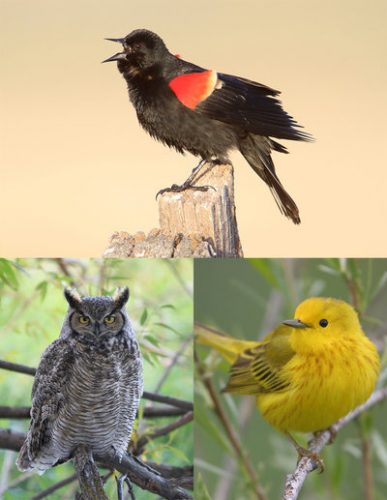
Last spring at the Malheur National Wildlife Refuge birdwatcher Tim Blount saw a bird that brought him back to his childhood in Nebraska. Up in a cottonwood tree was a black and white warbler, a small songbird with a high, piercing call (“weesy, weesy, weesy”) stopping on its way to northern Canada.
Black and white warblers are not commonly found at Malheur, as they typically migrate through the Midwest. These kinds of lone birds have a special allure for birdwatchers, and in the context of the dense flocks that pass through Malheur are widely referred to as “rare.”
A more accurate term, however, is “lost.” To see these vagrant birds in the Malheur, human wanderers need only go about five hours from Eugene to Oregon’s dry east side.
“It always gives me a cool little thrill when I get to see one at Malheur,” Blount says of the warblers. “There are a lot of good memories associated with that bird for some reason. Like a little zebra with feathers.”
Located in the high, sparsely populated sagebrush desert of southeast Oregon, the huge, fertile wetlands complex of Malheur Refuge is an unparalleled wellspring of bird life. Over the course of the year, Malheur is temporary home and fueling station to more than 320 bird species, from sandhill cranes and peregrine falcons to Bohemian waxwings, dusky flycatchers and even the odd semipalmated plover.
From now until the fall migration peters out and the wetlands freeze over, Malheur is an overwhelming and occasionally melancholy place to observe birds on their old journey south.
The popularity of Malheur for birds can be traced to its location along a key north-south migration route called the Pacific Flyway. Though its parameters are only apparent through observation of migrating birds, high-traffic routes like the Pacific Flyway are engrained in different ways into the heads of birds.
According to local ornithologist and author Noah Strycker, it is not entirely clear how birds know where to fly as the climate changes. But while research tells us that big birds like cranes learn routes from friends and families, Strycker says for “most small birds, it seems that a map is hardwired into their brains somehow and they just pick up and go.”
The reasons for “vagrancy,” the state of a “rare” bird straying onto a foreign flyway, are even more mysterious. Birds often seem to reflect human emotions, such as when sandhill cranes at Malheur “mourn” the death of their lifelong mate by standing beside them in the mud for weeks.
Vagrancy, some birdwatchers say, represents another complex emotion within birds. “Some people think it’s built into their genes, that there are these individuals that are hardwired to explore,” Strycker says. “Some people think that birds just make mistakes and get lost.”
Blount’s website, HarneyBirder.com, which documents the collective bird-watching efforts of Malheur’s wide-reaching birding community, has a whole section devoted to all-star vagrant birds sighted at Malheur in 2013 — a phainopepla, a crested songbird of the Southwest, spotted by Matt Obradovich and a jaw-dropping red and green glossy ibis normally found along the Atlantic Coast, reported by Christopher and Adrian Hinkle.
The appeal of vagrant birds is apparent, but according to British birdwatcher Tim Dee their presence should be bittersweet.
“Vagrancy is a death sentence,” Dee writes in his book A Year on the Wing. “They are wonderful treasures from far away that we cannot keep and cannot save. There is very little evidence that vagrant birds reorient themselves and correct their journeys.”
As long as vagrants grace Malheur, however, its wetlands will be that much richer, and human observers will have a greater chance of seeing their first bird.
“A lot of birders can tell you the first bird that they really noticed,” Blount says. “They may have seen birds all their life, but suddenly there’s the one bird that they saw that they actually noticed. It was a slate-colored junco in Nebraska that started it all for me. That bird did something — it clicked. And I’ve been pretty much worthless since then.”
If you are a newcomer to Malheur, stop at the Malheur National Wildlife Refuge Headquarters, where Fish & Wildlife employees can tell you where the birds are. According to Noah Strycker, it might be wise to start early and be still. To get to the Malheur take Hwy. 125 east to Hwy. 20 to Burns, then head south on 205.